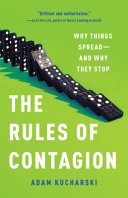
isbn-13: 9781541674318
Audible
This book was published just before Covid-19 hit but still has some relevant lessons for us today. It doesn’t just discuss viral contagion, but also financial crises, viral online contents and the spread of ideas. The author is a mathematician and professor of epedemiology.
Overall, an interesting but not essential read. Perhaps would have been a better book to actually read rather than listen to on Audible.
Some takeaways:
- Every outbreak is unique. While some outbreaks spread quickly, others ebb off just as fast.
- Mathematical models help show the growth of epidemics.
- Contagions can affect many industries, including the financial industry.
- Contagions can also spread through your social circle.
- Gun violence may be a type of behavior that’s socially contagious.
- Social behavior online may be different from real life. Abusive “trolling” behavior is common.
- Using big data can help with outbreak research but it’s not a panacea.
Publisher’s Description: “From ad servers to Zika, Ebola to fake news, why the science of infection is the science of modern life In our social-media-laden lives, everyone thinks they understand how things, whether YouTube fads or bank failures, spread: they go viral. In The Rules of Contagion, Adam Kucharski unpacks the science of epidemiology – the movement of diseases – to reveal what is, and isn’t, viral in modern life. Is it true that fake news spreads because it’s an unstoppable mind virus? Actually, brute-force attacks on our attention, not manipulation, explain most of it. Exploring everything from the onset of riots to the power of Instagram influencers, Kucharski shows how hackneyed the popular understanding of virality can be, and how much more compelling the real story is. Whether you are an author seeking an audience, a defender of the truth, or simply someone interested in the science of human social behavior, The Rules of Contagion is essential guide to modern life.”